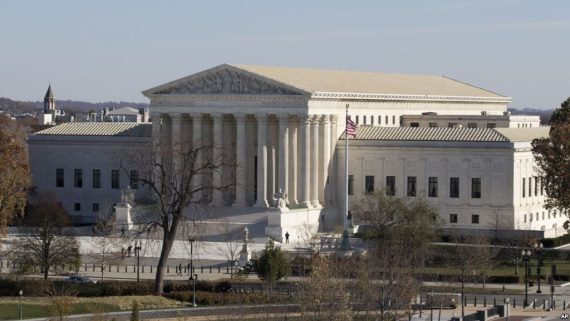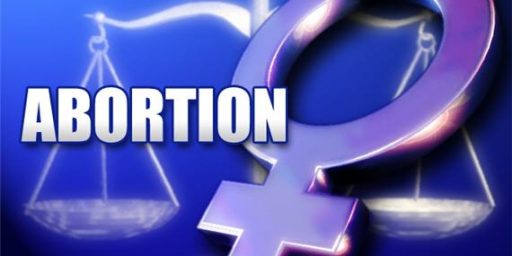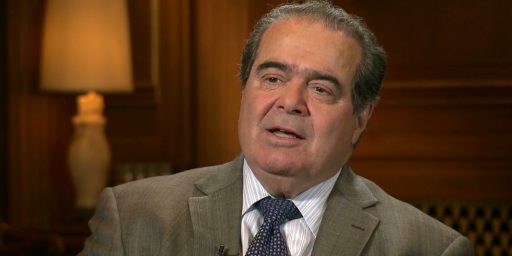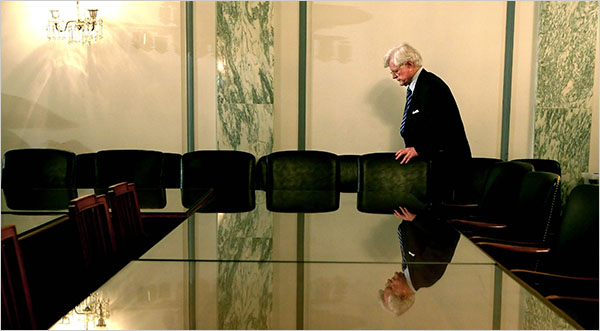The Beginning Of The End Of The ‘Conservative’ Supreme Court
Depending on the outcome of the election, the Supreme Court's just concluded term will most likely be remembered as the point at which the Court's rightward tilt that began at the end of the Warren Court Era came to an end.
New York Times Supreme Court reporter Adam Liptak notes that what was supposed to have been a term in which the Supreme Court’s conservatives steered the nation’s highest Court in a decidedly more conservative direction instead ended up moving the Court somewhat to the left on several important issues, and suggests where the Court may be headed depending on the outcome of the election:
WASHINGTON — Conservatives thought this Supreme Court term would be different.
Still reeling from losses last year in major cases on health care and same-sex marriage, they welcomed a new docket in October studded with cases that seemed poised to move the law to the right.
But then came two unexpected turns of events. Justice Antonin Scalia, the longest-serving member of the court’s five-justice conservative wing, died. And Justice Anthony M. Kennedy veered left in two of the term’s biggest cases, joining the court’s liberals in significant decisions favoring affirmative action and abortion rights.
For the second term in a row, the court led by Chief Justice John G. Roberts Jr. delivered liberal decisions at a rate not seen since the famously liberal court led by Chief Justice Earl Warren in the 1950s and 1960s.
Yet the court, which ended its term on Monday, remains in a period of great transition. With one vacant seat and the possibility of more to come, it is almost certainly entering a new era, the shape of which will depend on the outcome of the presidential election.
For now, Justice Scalia’s absence has handed Chief Justice Roberts the difficult task of steering his colleagues toward consensus in big cases. Over the past term, when he succeeded the resulting decisions were sometimes so narrow that they barely qualified as rulings. When he failed, the court either deadlocked or left him in dissent.
Before Justice Scalia died, the court had agreed to hear cases that conservative advocacy groups hoped would help business interests and Republican politicians, while dealing setbacks to public unions, colleges with racial admissions preferences and abortion providers. Just four days before his death, the court seemed to send an assertive signal, blocking the Obama administration’s effort to combat global warming by regulating emissions from coal-fired power plants. The vote was 5 to 4, with the court’s conservatives in the majority.
As soon as it was announced that Justice Scalia had died, it was apparent that his absence from the Court would have a significant impact on the remainder of the Court’s current term, especially since it was evident that it was unlikely that any replacement could be approved in time to participate in the briefing, argument, and decision of the remaining cases even if the Senate had decided to move expeditiously on the President’s nomination. I detailed many of the cases where Scalia’s death would likely have an impact and it didn’t take long for that impact to begin to manifest itself. In Friedrichs v. California Teachers Association, for example, the Court split 4-4 in a case when, based on oral argument, it was apparent that Scalia would have joined the Court’s four conservatives in handing public employee unions a major defeat. Instead, the tie meant that the ruling below by the Ninth Circuit Court of Appeals stood and what could have been a major loss for unions turned into a major victory instead. Similarly, the Supreme Court ended up in a 4-4 tie in the case filed by Texas and a group of other states challenging President Obama’s executive action on immigration. While that decision did let the stay imposed by the lower court stand, the absence of Justice Scalia meant that the Court was unable to issue the more sweeping ruling that it seemed to contemplate when it accepted the case for review. Other cases in which the Court seemingly moved to the left in the absence of Justice Scalia include the latest challenge to the PPACA’s birth control mandate, a challenge to the meaning of ‘one person, one vote,’ and, of course, the challenge to Texas’s abortion law, which resulted in a decision that largely reaffirms Roe v. Wade and the Court’s 1992 holding in Planned Parenthood v. Casey. While Justice Scalia’s vote would not have made a difference in these cases, one can argue that the loss of his rhetorical voice may have resulted in other Justices becoming more assertive:
Vikram Amar, dean of the University of Illinois College of Law, said there had been a change in tone at the court since Justice Scalia died. “In Fisher,” Dean Amar said, “even though the dissent Justice Alito read from the bench was frank, it was not as barbed and incendiary as Justice Scalia’s likely would have been.”
Justice Kennedy also joined the court’s liberals in a 5-to-3 decision on Monday striking down parts of a restrictive Texas abortion law and strengthening the “undue burden” standard that the court announced in 1992.
The silencing of Justice Scalia’s voice seemed to help other justices find theirs. Two weeks after Justice Scalia died, Justice Clarence Thomas broke a decade-long silence by asking questions from the bench.
Justice Sonia Sotomayor, already a major presence at arguments, took on an even larger role. This month, she wrote a lashing dissent, rooted in the concerns of the Black Lives Matter movement, in a case on police stops.
Justice Thomas remained the most conservative member of the court based on voting patterns this term, while Justice Sotomayor overtook Justice Ruth Bader Ginsburg as the most liberal one, according to an analysis by Lee Epstein, a law professor and political scientist at Washington University in St. Louis, and Kevin Quinn, a political scientist at the University of California, Berkeley.
Justice Sotomayor’s votes in criminal cases also make her one of the most liberal justices since 1937, while Justice Alito is among the most conservative, to the right of even Justice Thomas.
In all, though, the justices are doing what they can to find common ground, Professor Epstein said.
“Without Scalia, it’s still the Kennedy court, but Kagan and Breyer had a very good term,” she said. “Both were in the majority in divided cases over 80 percent of the time, and the Democratic side of the court yet again won victories in some of the term’s biggest cases.”
Beginning in the 1970s with the appointment of Justices such as Warren Burger and William Rehnquist, the Supreme Court slowly began moving away from the leftward tilt it had taken under the leadership of the late Chief Justice Earl Warren, and Justices William Brennan and Thurgood Marshall. While the Court did not go so far as to reverse the landmark rulings of the Warren Court Era in areas such as race relations and criminal law, the presence of Justices such as Burger, Rehnquist, and, for a time, John Paul Stevens and Lewis Powell, on the Court did mean that the Court never did take those areas of the law where some legal advocates on the left had hoped they would eventually go. Eventually, as Justices such as Brennan, Blackmun, Marshall and others were replaced with names like Scalia, Kennedy, and Thomas, with Rehnquist replacing middle-of-the-road Warren Burger as Chief Justice, and the Court continued to move slowly to the right. All of this culminated in the appointment of Chief Justice Roberts and Justice Samuel Alito by President George W. Bush, a move which effectively solidified a conservative core to the Supreme Court that even President Obama’s appointment of Justices Sotomayor and Kagan did not significantly push back on. To put this in perspective, of the There were exceptions, of course, most notably cases such as Roe v. Wade, which was handed down during the early part of the Court’s move to the right, and Planned Parenthood v. Casey, which was handed down in 1992. Later in this period, the Court handed down a series of cases ranging from Lawrence v. Texas and ending with Obergefell v. Hodges which slowly expanded the legal protections available to gays and lesbians under the law. More recently, the right faced disappointment in its Constitutional and statutory challenges to the Affordable Care Act thanks to Chief Justice Roberts siding with the Court’s liberal minority to uphold the law. For the most part, though, the Court’s rulings during this period titled toward the right, and this was supposed to be the year in which conservatives scored significant victories in a wide variety of areas. Instead, thanks in part to the death of Justice Scalia, they faced disappointment and, now, the possibility that the Courts may soon become a much less friendly venue.
Richard Primus of the University of Michigan Law School argues that this term marked the beginning of the end of the Supreme Court’s rightward tilt:
The presidential election is still months away, and Clinton’s election is by no means a certainty. But if it happens, a long period in constitutional development will have come to a close. The conservative victories of the past several decades will not be for naught: A great deal of law has changed, and it will not all be unraveled. But the direction will be different. Rather than asking whether abortion and affirmative action will continue, courts will ask about this or that aspect of abortion or affirmative action on the broad understanding that the practice in some form is secure.
And rather than trying to defend a decades-old status quo against further erosion, liberal constitutional lawyers will start thinking about where they would like to take initiative. Both sides will need to go through a process of adjusting their roles, shifting from offense to defense or vice versa—as they have done before, in other directions, and as they surely will again at some time in the future.
It’s at least possible, albeit not likely given the currently available evidence, that Donald Trump will win the election in November and that, assuming he gets the opportunity to do so, he will appoint relatively conservative Judges to replace those who may leave the bench, then this year, and likely a good part of the next term as well, will mark a mere hiccup for a long term move to the right on the Supreme Court. In all likelihood, though, it’s Hillary Clinton who will appoint new members to the Supreme Court, a task that could begin with appointing Justice Scalia’s successor unless a lame duck Senate moves to confirm Merrick Garland during the lame duck session after the election. Some of those appointments, such as hypothetical successors for Ruth Bader Ginsburg and Stephen Breyer, won’t really have an impact on the direction of the Court, but the Garland appointment most certainly would, and a replacement for Justice Kennedy by a Democratic President would significantly alter the direction of the Court even more than the selection of Justice Scalia’s replacement. At that point, the Court would start moving in a new direction, and it’s not one that conservatives are likely to be happy with. So, depending on the outcome of the election in November, this year will mark either a hiccup for judicial conservatives, or the beginning of the end of a period that began under President Nixon and which had a significant role in shaping Constitutional law and the Courts for the better part of a century. It will take time for that process to work itself out, just as it did during the period that began in 1969, but if Trump loses the outcome seems inevitable. Perhaps Republicans should have given some thought to that before nominating him.







The Supreme Court has not had a right-ward tilt in years. It has upheld very large racial preferences (Grutter v. Bollinger (2003)), made it almost impossible to regulate partial birth abortion (Stenberg v. Carhart), overturned state and federal criminal sentencing systems under its Booker-Apprendi line of cases, overturned the death penalty as imposed by judges (rather than juries), overturned life without parole for serial murdering teenagers, and required that all 50 states recognize gay marriage (gay marriage is a good idea, but hardly one mandated by the Constitution). As Ted Frank and others have noted, it has also ruled against business in most big ticket item cases (especially employment law), while ruling for business in smaller ticket cases (no ordinary business owner cares about Citizens United, which involved a right-wing nonprofit that wanted to criticize Hillary Clinton).
My impression of the court since Bush v. Gore is the opposite of Passerby’s. Well, that’s not quite true. While Scalia went around flapping his jaws about conservative principles (small “c”) guiding the court, it seemed the focus on the past couple of decades has been protecting the powerful and harrassing the weak, with a healthy dose of “support the Republican agenda” thrown in (Bush v. Gore and magically finding that states cannot regulate guns after 200 years of opposite rulings) So the court was not “conservative in any meaningful sense but was Republican in significant ways.
@Passerby:
Are you saying that ‘ordinary’ business owners (as voters) do not care about money in politics?
Not being nitpicky here–I’m genuinely curious as to the perspective you were going to lay out.
Scalia did his all to make this country less fair, less tolerant, and less safe. In pioneering originalism he said that a few white slave holders in the 18th century knew more about the modern world than we do, and made us more backward looking, than forward, in the process.
So to the degree that this is the beginning of the end of “his” court…good for the Republic.
Even in the apocalyptic version of the future that features a President Trump, the Supreme Court will get less conservative. He’s arguably more liberal than Hillary on the social issues and Senate Republicans wouldn’t reflexively oppose his nominees in the way they would hers.
@Passerby:
Wow. I wonder what color the sky is in your world. Because I can’t think of ways in which you could be more wrong.
Citizen’s United.
Hobby Lobby.
Shelby County Vs. Holder
Kelo Vs. City of New London
Just for starters.
@James Joyner:
Indeed…the anti-choice set is freaking out over his apparent lack of tweets regarding the SCOTUS abortion ruling.
And now famed homophobe Dr. James Dobson is walking back his claim that Trump is born-again.
Whenever a liberal justice retired, we’d all hear about how important it was to preserve the “ideological balance” of the Court and nominate a candidate who was in a similar mold to the outgoing Justice.
I guess that rule only applies when it’s a Republican president.
@James Joyner: The reverse of your reasoning is that Trump doesn’t care much about the Supreme Court and, consistent with the list he issued, would be more likely to view those nominations as a bone he can throw to traditional Republicans.
In the last few years the Supreme Court has moved toward making laws and rewriting the Constitution.This kind of power in the judicial branch was not intended when the founders created the Constitution and the three branches of government.
Judge Warren – still talked about around here.
True. Many lives will have been ruined in the meantime. That has to count for something…
@Tyrell: I take it not as in speculation about Elizabeth Warren as a nominee, but as in “Impeach Earl Warren”. Those people need to get a life.
@Jenos Idanian: Like when Clarence Thomas replaced Thurgood Marshall.
@Jenos Idanian:
You’re right, actually. I hate to admit, but man, you are right. It’s what’s really been bothering me over this whole Merrick Garland kerfuffle. I mean, don’t the people criticizing the GOP realize that, yes, they are trying to turn the SC into a partisan tool in a way never imagined or attempted before, and yes, they are creating an insanely dangerous precedent, doing so knowingly in a chamber that functions on decorum and precedent, but haven’t liberals also written articles in the past about the need for balance on the court? And isn’t that exactly the same thing?
It’s really time for this “IOKIYADism” to stop.
If , as I think likely, Clinton wins and has a Democratic Senate majority, she will likely have three Supreme Court picks, replacing Scalia, Ginsberg, and Breyer.( I believe Garland’s nomination is doomed). Those likely picks will be young , liberal judges in their early 50s, following the playbook established by the Federalist Society.
That will give the Court the first liberal majority since 1969 and determine the direction of the Court for the next two decades. Those appointments may be the most important thing she does as President.
Try to imagine a Court where the swing vote is Elena Kagan and not Kennedy or Roberts. That would be a huge change.
And to complete the conservative nightmare, imagine Tom Perez as A-G. A liberal can dream..
@Joe: I don’t think Trump would see SCOTUS nominations as a bone to throw. I think he would see them as actual work, and avoid them like the plague. They’d be something he could dump off on the Party
I won’t be able to stop laughing on the day that Heller is overturned, while McDonald v Chicago incorporates that result for all 50 states.
@Jenos Idanian:
“Whenever a liberal justice retired, we’d all hear about how important it was to preserve the “ideological balance” of the Court and nominate a candidate who was in a similar mold to the outgoing Justice.”
Please. You are just embarrassing yourself this time. Your logic would lead to Democrats opposing on ideological grounds the replacement of Thurgood Marshall with Clarence Thomas (for whom the opposition was not over the difference in judicial philosophies), William Douglas with John Paul Stevens (confirmed 98-0 when the Democrats controlled the Senate), or William Brennan with David Souter (confirmed 90-9 when the Democrats controlled the Senate). And to forestall the inevitable response, neither Stevens nor Souter were expected to be left of center when they were nominated, and neither actually were left of center for their first few years on the Supreme Court bench..
@gVOR08:
No…he’d friggin’ sell them…like his crappy steaks or shitty vodka or his fraudulent real estate classes. And the Justies would have TRUMP emblazoned in gold on the back of their robes.
@Tyrell:
Yea, about that – Marbury v. Madison. It is impossible for a court to apply the constitution in evaluating legal matters without it having the authority to determine what the verbiage of the Constitution actually means. We settled this in 1803 – 213 years ago.
And by “we”, I mean the regions of the country which weren’t intent on preserving segregation.
@Jenos Idanian:
Conservatives set out in the 1980s with the explicit goal of packing the court in order to overturn Roe v. Wade. Roosevelt did it on even more egregious terms in the 1930s. We fully intend to do everything in our power to do it once Clinton is elected as well. No equivocating there. I’ll blatantly admit that packing the court with young, spry liberals who’ll torpedo any hope of a conservative revival for a generation is absolutely our goal.
Trying to pack the court to your political advantage is as old as the country is. Both sides indeed do it and it’s nothing new. The difference here is that you’re facing being on the losing end of that admittedly partisan pursuit this time around and you don’t like it
I read that Politico article and thought that it would be more complete if it connected the predicted move to the left by the Supremes with the various changes in demographics and political geography that we liberals are calling the ‘blue wall’.
And my friend Stonetools — don’t you mean doing the opposite of the Federalist Society? There is a leftward organization that AFAIK balances the conservative Federalists but d*mned if I can call the name up from the depths of my brain at present. Growing old is so much fun.
@Neil Hudelson:
Balance, yes – status quo, no. There are no seat stamped “Republican”, “Democrat”, “Conservative” or “Liberal”. Nowhere does it say once a tilt is established it must be maintained. In fact, not moving would be unnatural despite what the party out of favor protests. The current whining is because, in an attempt to make sure this “balance” is maintained, Justices that should have retired waited and now we’ve got a bunch of openings (current and future) in a short amount of time instead of spaced out.
Look at what even a rumor of Thomas retiring stirred up. A clever GOP would persuade him to step down and present a package deal to Obama – we give you Garland and we get a fairly rightward Justice, bare minimum kabuki please. Obama takes it, knowing RBG can safely go once Hillary walks in the Oval Office. There, balance with a leftish tilt instead of a right but better then losing any more. Then again, if the GOP were clever, we wouldn’t be having this discussion…..
@James Joyner:
Do you honestly think you know where Trump stands on any issue (beyond “What’s good for Trump is good”)?
Face it James, Trump’s only core conviction is his own self-interest. Beyond that, he’s a glorified car salesman. He will tell any audience whatever it is he thinks they want to hear. He is not about anything, beyond sealing the deal and then moving on to the next group of suckers.
@JohnMcC:
Yeah, What I meant to say is that the Federalist Society wrote-and to a certain extent- executed the strategy on how to pack the federal courts with judges of a particular stripe-in their case, conservative ideologues.
The liberal analogue is supposed to be the American Constitution Society, but it’s much less influential for the Democrats than the Federalist Society is for the Republicans. The Federalist Society seems to virtually run the Federal judicial selection process for the Republicans.
balance sounds good. We’ve just had 200 years of elderly white christian men as jurists. 200 years of middle-aged minority pagan women should balance things nicely.
Passerby, Jenos, Jack, please go ahead and make appointments with your doctors for blood pressure meds. Because a year from now, the liberals will have 5 solid votes on the SCOTUS. You think you’re unhappy now? Ho ho ho!
Will Chief Justice Roberts stay chief justice under the circumstances? I know he will initially, I mean, over the medium-to-long term.
@C. Clavin: Have a source for this? I was looking and couldn’t find one. I’m not saying it isn’t true, but I’d like to read it because I’ve not been a Dobson fan for a long time.
Have I missed something here? The Pres nominates, and the Senate
(or not).
It just seems to me that relative to new Supreme Court Justices, whoever holds control of the Senate really is who controls who will take up vacancies.
Over and over I’ve been told by my republican cohorts that “we can’t let the SC fall into Clinton’s hands” — so we must vote for Trump.
If it’s control over who fills SC seats that has them in panic – then they should concentrate of Senate races rather than Presidential. And if dumping Trump improves their down ballot race position, perhaps that what they should seriously consider..
OR maybe there is just something I don’t understand.
@Jenos Idanian: No, that was only partisan bullshirt and you know it. The only difference is that we’re hearing it from the right this time, and you’re in denial about THAT.
Thank you for giving me the opportunity to “rub [your] face in [your] own hypocrisy.” (A famous poster here said that.)
@anjin-san:
We don’t disagree here. I think Hillary is left by 1970s standards but pretty mainstream on most of the social issues and has been steeped in the debates on them for decades. I think Trump is reflexively left-libertarian on the social issues but hasn’t really thought through them since thinking isn’t exactly his strong suit.
@EddieInCA:
Kelo is a conservative decision? You realize Kelo was decided by the liberal side of the bench supporting the government and the conservative side in minority opposing it?
To be fair, this leftward tilt of the Court would still be rightward of where it was during the 60’s. The Court has rarely, in recent years, shaken the Constitutional ground or massively rewritten laws. It has generally erred toward judicial restraint of not overturning laws (e.g., Obamacare) or overturning them on a fairly narrow basis (e.g., Hobby Lobby). And most of the decisions it makes are unanimous or have large majority. We tend to focus on the handful of decisions that split the Court. So I’m resistant to this notion that the Court is going to veer wildly liberal. If Republicans hold onto Congress, they will still control the agenda.
PS – I also resist this narrative that the Court has been crazy conservative over the last decade or so. What is has been is conservative with hysterical reactions by the Left Wing to every decision that doesn’t go their way (e.g., the cries of “theocracy” following the Hobby Lobby decision). Not that conservative are immune from this, obviously, given some of their hysterical reactions to, for example, the Obamacare decisions.
@Tyrell:
The first time I recall hearing someone say that was in about 1965. HL92 says the trend for thinking that goes back further, so I will defer to his greater knowledge.
@HarvardLaw92: That is exactly my point – we are agreed !
The president and Congress have thrown the ball back and forth more than the LA Dodgers infielders – “I’ve got it, no you take it” so that nothing gets done and all this stuff winds up in the Supreme Court and I can imagine their frustration on handling it. Judge Kennedy even said that too many things are winding up going to court that should be worked out and settled. A lot of times a committee made up of various citizens could study these issues and problems and come up with far more sensible and workable solutions.
What is needed is the Nixon progressivism combined some good Jacksonian economic policies and everything would work out. Maybe it is just the heat, but it is summer and I have seen hotter. Back in the ‘80’s we had summers where the thermometer stuck on 98 most days. People quit looking at them.
But Judge Kennedy was appointed by President Reagan. So you can’t predict how their going to turn out. Judge Warren was appointed by Eisenhower and look how that went. I imagine if Judge Warren could come back today and look at the schools and the Common Core “funny numbers” stuff he would agree that “the schools don’t have a prayer !” Actually Warren’s decision did not take prayer out – students were and still are free to pray on their own and at any time – how could the government control that anyway ? The schools just could not have organized prayer. Now the local schools pto have their people that usually start a meeting with a prayer, but what can you do about that ? These are volunteers and the schools certainly do not want to make them mad and have them quit ! But people still talk about that Judge Warren.
I am out of here for a while – headed to the land of sun and fun – the beach
“Under the board walk, down by the sea
You can almost taste the hot dogs and French fries they sell” (The Drifters – greatest beach song of all)
@HarvardLaw92: “Roosevelt did it on even more egregious terms in the 1930s. ”
More like *tried* to do it on egregious terms.
@Hal_10000: “Kelo is a conservative decision? You realize Kelo was decided by the liberal side of the bench supporting the government and the conservative side in minority opposing it?”
From what I understand, Kelo reaffirmed existing precedents. That would be ‘conservative’. Now, people who are right-wing generally don’t understand conservativism.
@James Joyner:
I don’t even know what that might mean, but I think you’re still making a category error by attributing ANY position / philosophy / ideology / filter to Trump. You are projecting your own rationality onto Trump, and it’s a poor fit. There is no generating principle for Trump positions beyond “what would be useful to promote at the moment?”. You might just as productively speculate that your 2-year-old kid leans left-libertarian.
@Barry:
The context was correct. Republicans set out to pack. Roosevelt set out to pack, i.e. He did it too. We’re about to set out to pack as well.
@DrDaveT :
To be fair to James, it’s a very common mistake to make. We assume a classification system means everything can be classified – every species has a name even if we just haven’t named it yet. Furthermore we assume a basic level of rationality in others as a default human state of being. After all, if you were sitting on a burning mattress, would you not get off it for your own safety/comfort? Would it not be deeply shocking to watch someone unconcerned that the fire creeps closer and has no intention of moving? We assume that since we possess this base logic and self-preservation that everyone else does too. This is why your average person has difficulty understanding mental illness; look at a extreme hoarder, for instance, and try to understand their mindset amidst the overflowing piles of trash blocking off the exits and filth threatening health and safety. They have a reason for doing it – it’s just not your reason or one that makes traditional logical sense. Talking about cleaning with them is speaking another language you are not even remotely fluent in.
The thing is, Trump’s not rational in a way that defies typical political understanding. Egotists of that level will doing anything, say anything to keep it all about them. They cannot be classified as anything other then self-centered. Attempts to parse his behavior yield results that kinda-sorta look libertarian so therefore he’s libertarian-ish, right? Nope. There is no coherence to his policies/ramblings other then What His Verbal Diarrhea Is Currently Sqwaking. James is seeking to make sense of the insensible because logic dictates Trump must exist in the classification system somewhere. Too bad we don’t have a Misc slot to tag him as.
@HarvardLaw92: FDR did eventually get more favorable justices appointed. But Roosevelt court packing refers to his proposed legislation to increase the size of the court, allowing him to add favorable appointees, a different thing than nominating replacement Justices. Opinion seems to differ as to whether FDR was serious about this or putting pressure on the court. The bill failed but by then the Court was ruling more in his favor. The apparent change of heart by one Justice being referred to at the time as the switch in time that saved nine.
@gVOR08:
Different methods, same goal. The broader point is that everybody tries to pack the court, and they always have.